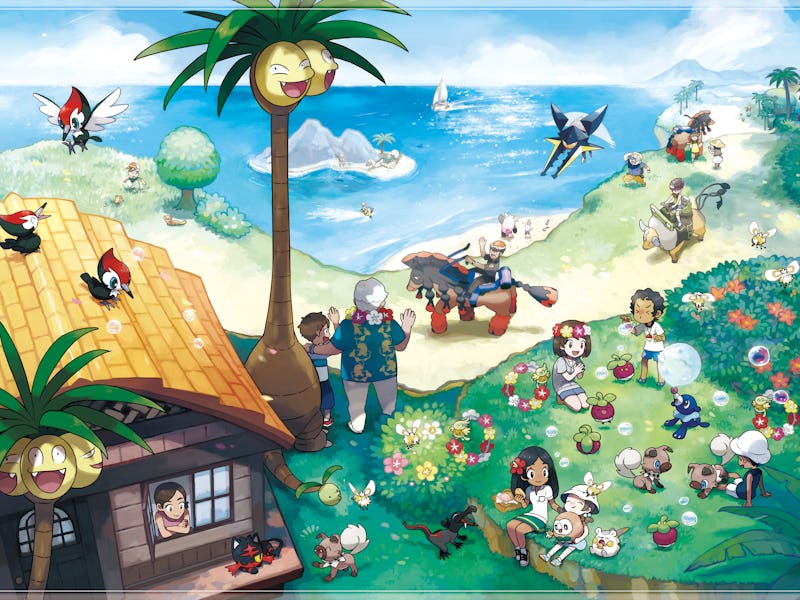Darwinian Natural Selection Is at Work in 'Pokemon Sun' and 'Moon'
Even in the Pokemon universe, species have no choice but to adapt or die.

Pokemon fans awaiting the release of Pokemon Sun and Moon received a lesson in Darwinian evolution Monday after Nintendo released new information about the never-before-seen Pokemon living in the mysterious new Alola Region, where Pokemon Company International announced that Exeggutor, Vulpix, Ninetails, Sandshrew, and Sandslash will appear slightly different after having “adapted to the Alola region.”
The developers of Sun and Moon have admitted in interviews that the Alola Region is essentially a cartoon facsimile of the Hawaiian archipelago. In the real-life island cluster, animal populations have adapted, through generations of natural selection, to their water-locked environment; the restrictions imposed by their habitat, like limited food and abundant predators, encouraged the proliferation of individuals with certain, advantageous genes — and the widespread death of those without.
It appears that the same forces were at work among the Alolan Pokemon.
It's possible that generations of natural selection resulted in the all-white Alolian Vulpix.
Take, for example, the Alolan Vulpix, a new species of the adorable, russet-haired Pokemon fox. The Vulpix is said to have first come to the Alola region with humans, but later “moved to the snowy mountain peaks to avoid the normal habitats of other Pokémon,” thus taking on its new form, an ice-white, blue-eyed cloud of impossible cuteness. If we take a moment to unpack this statement, a saga of Darwinian evolution is revealed.
Here’s what probably happened, assuming natural selection in the Pokemon universe works in the same way it does on Earth. The original red Vulpix population was probably threatened by other Pokemon in the island lowlands, perhaps by Alolan Sandshrews and Exeggutors that either preyed on them directly or competed with them for food or trainer attention. When some quirk of Pokemon genetics created an all-white Vulpix that was able to survive and thrive in the Alolan mountains, far away from its competitors, it gave natural selection something to work on: As the original red-haired foxes were killed off by starvation and Pokemon-on-Pokemon violence, the albino Vulpixes, protected by their inhospitable surroundings and camouflaged by their white coats, were able to live long enough to pass their genes onto the next generation. After multiple generations of Vulpixes were subjected to the forces of natural selection, a new species — the Alolan Vulpix — emerged.
It's possible that natural selection led to the evolution of the Alolan Sandshrew, better suited than the original to living in snowy environments.
There are similar stories implicit in the shorthand biographies of the other new, all-white Pokemon species, some of which ostensibly evolved new ice-based attacks through natural selection in addition to changing their looks. The Alolan Ninetales, for example, seems to carry a set of genes that allows it to form ice crystals from its fur, which is, undoubtedly, an asset to any Pokemon attempting to thrive on the island’s snowy mountaintops. The island’s Exeggutor species didn’t quite take on a monochrome coat, but it evolved a fourth head on its tail; are the Alolan islands rife with low-lying predators that forced the persistence of this genetic mutation? Perhaps — only the game’s developers can say for sure.
Considering that Pokemon’s creator, Satoshi Tajiri, was an amateur entomologist, it’s not surprising that a strong undercurrent of evolutionary theory underlies much of its backstory. Admittedly, the concept was, until now, very liberally applied, with the term “evolution” incorrectly being interchanged with “metamorphosis”; as Max Planck Institute fellow Dr. Matan Shelomi noted in an interview with Inverse, “[Evolution] is not the right word, but it stuck.” But the new information about Sun and Moon suggest that the game’s developers have been brushing up on their Darwin.
It’s understandable, however, why Pokemon’s creators won’t want to dwell on evolutionary theory too much. Natural selection is a brutal thing, one that involves indifferent deaths and violent predation — evolutionary processes that seem too cold and too ruthless to apply to something as cute as a furry white fox. And yet, today’s press release suggests that those dark forces are at play behind the scenes, calling to mind a stirring moment in the 2005 documentary Grizzly Man, in which a sorrowful activist contemplates the senseless death of a young fox, not unlike the rust-hued Vulpix. “I believe the common denominator of the Universe is not harmony, but chaos, hostility and murder,” director Werner Herzog resignedly says in voiceover. Despite its happy sheen, the Pokemon Universe, it seems, operates by the same heartless laws.